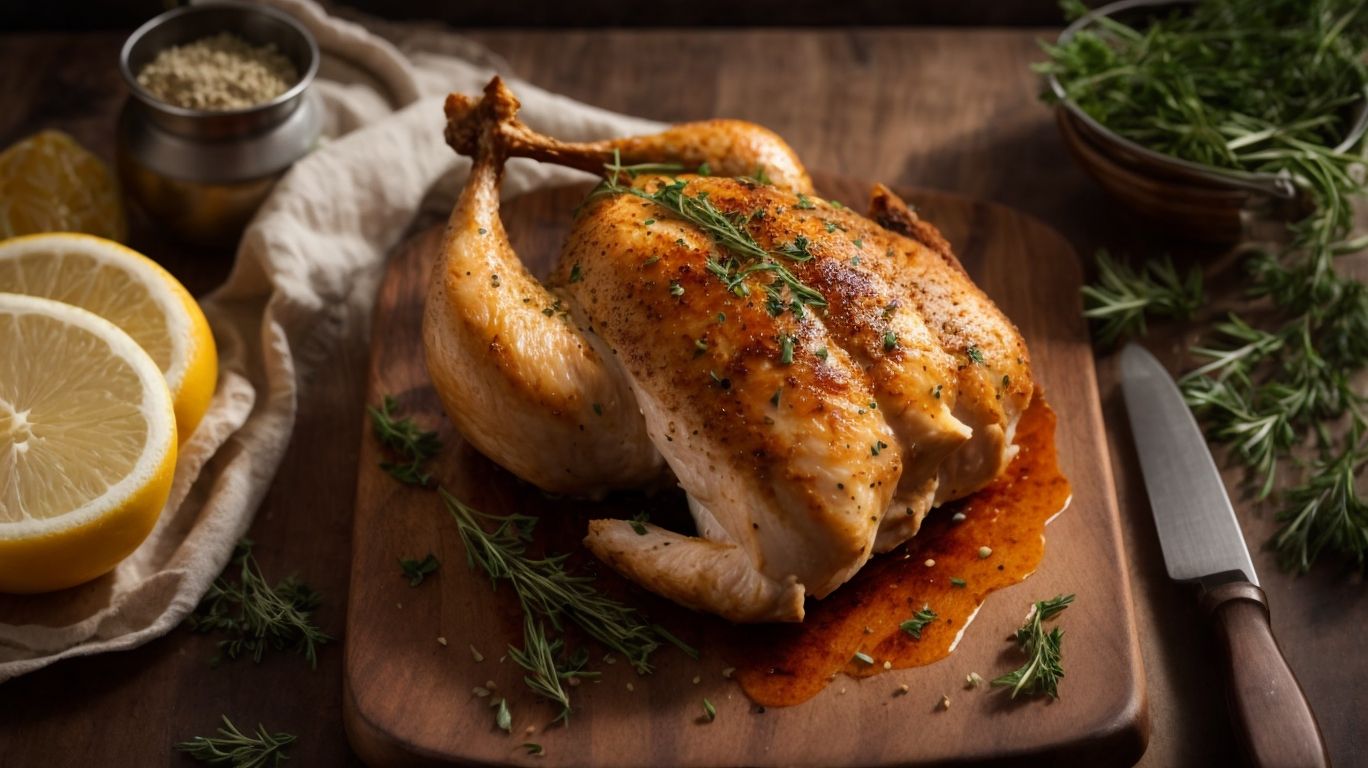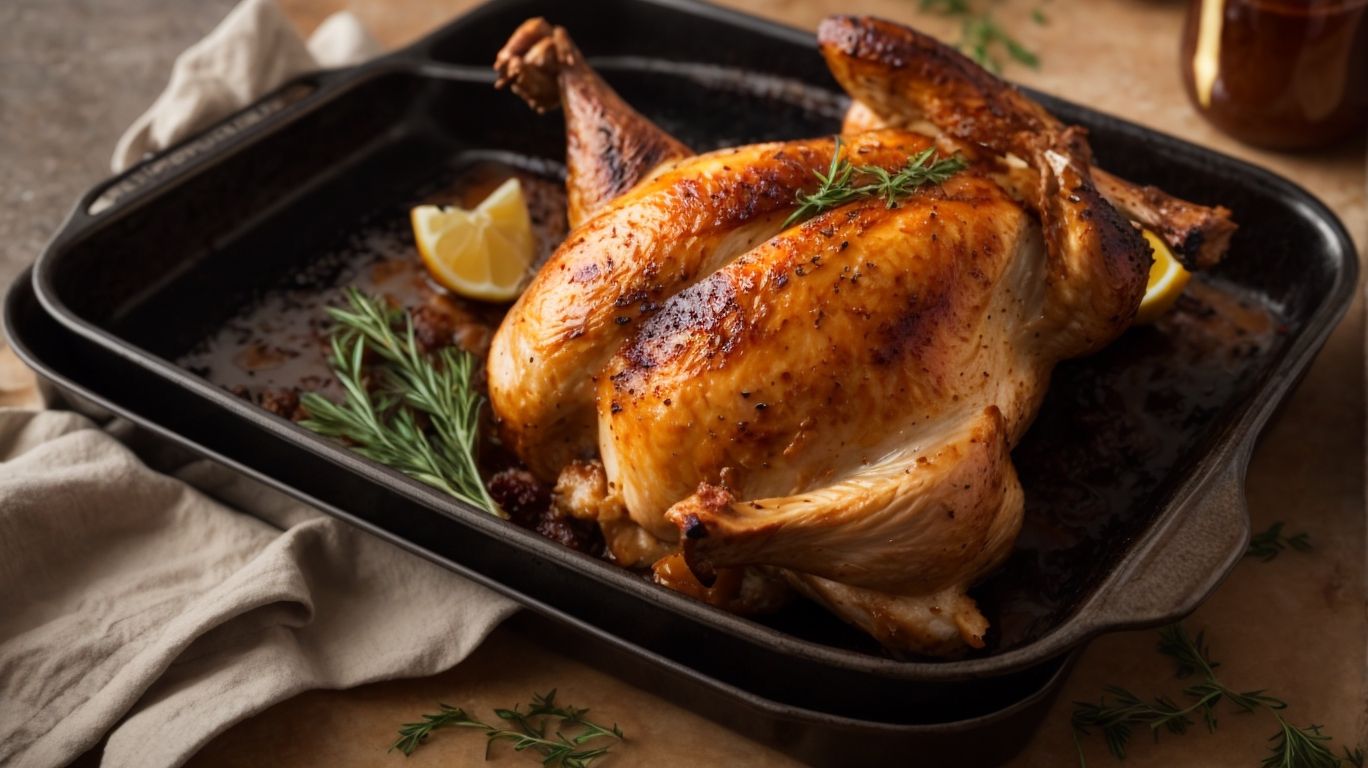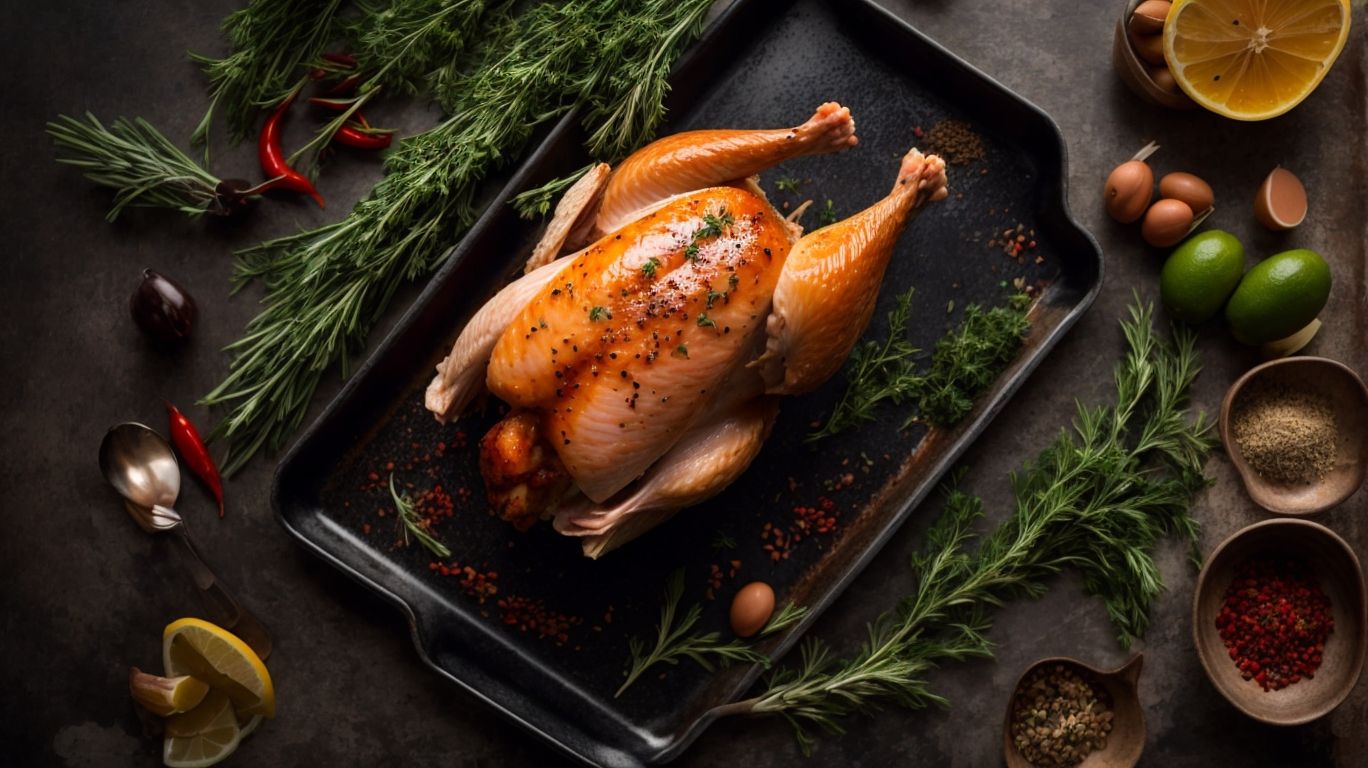How to Bake Undercooked Chicken?
Are you aware of the dangers of undercooked chicken?
From the risk of foodborne illnesses to the presence of harmful bacteria, it’s crucial to handle chicken safely.
In this article, we will discuss how to tell if chicken is undercooked, how to handle it safely, and how to bake it to perfection.
With tips on adjusting oven temperature, using a meat thermometer, and adding moisture, you’ll learn how to ensure your chicken is cooked through and delicious.
Stay tuned for expert advice and culinary tips from a seasoned chef!
Key Takeaways:
Why is Undercooked Chicken Dangerous?

Credits: Poormet.Com – Joe Wilson
Undercooked chicken poses significant health risks due to the potential presence of harmful bacteria, leading to foodborne illnesses.
Consuming undercooked chicken can expose individuals to dangerous pathogens such as Salmonella, Campylobacter, and E.coli, which can result in symptoms like nausea, vomiting, diarrhea, and even more severe complications.
Proper cooking techniques, such as ensuring the internal temperature reaches at least 165°F (74°C), are crucial in killing these harmful bacteria and preventing foodborne illnesses.
Cross-contamination with other food items can occur if raw chicken comes in contact with surfaces or utensils, emphasizing the importance of proper food handling and hygiene practices in the kitchen.
Risk of Foodborne Illnesses
Consuming undercooked chicken increases the risk of foodborne illnesses, such as salmonella infection, which can result in severe digestive problems.
Undercooked chicken can also lead to other bacterial infections like Campylobacter jejuni and Clostridium perfringens, causing symptoms such as diarrhea, vomiting, abdominal cramps, and fever. These symptoms usually manifest within a few hours to a few days after consumption, depending on the type of bacteria involved.
Treatment for foodborne illnesses typically involves staying hydrated and getting plenty of rest. In severe cases, antibiotics may be prescribed. Prevention is key when it comes to food safety. Cooking chicken to an internal temperature of 165°F (74°C) can help kill harmful bacteria and reduce the risk of contamination. It is also crucial to avoid cross-contamination by keeping raw chicken separate from other foods, and practicing proper hand hygiene before and after handling raw poultry.
Presence of Harmful Bacteria
Undercooked chicken harbors harmful bacteria like salmonella and campylobacter, highlighting the importance of proper cooking and reheating methods to eliminate these pathogens.
Salmonella and campylobacter are two of the most common bacteria found in undercooked chicken. These pathogens can cause foodborne illnesses with symptoms like nausea, vomiting, and diarrhea. Cooking chicken to the appropriate temperature is crucial in killing these bacteria. Using a meat thermometer to ensure that the internal temperature reaches at least 165°F (74°C) is essential.
When reheating chicken, it’s important to do so quickly and thoroughly. Reheat leftovers to an internal temperature of 165°F (74°C) to kill any remaining bacteria. Avoid reheating multiple times as it can increase the risk of bacterial growth. Always refrigerate leftover chicken promptly to prevent bacterial contamination.
How to Tell if Chicken is Undercooked?
Identifying undercooked chicken can be done through visual cues such as pink flesh and checking the internal temperature to ensure it reaches the recommended level.
Apart from color and texture, using a meat thermometer is a foolproof way to ensure that chicken is thoroughly cooked. Insert the thermometer into the thickest part of the meat without touching bone, and wait for a stable reading. For chicken, the internal temperature should reach at least 165°F (74°C) to guarantee it is safe to eat. This method is especially useful for larger cuts or whole birds where visual indicators may be insufficient. Remember, proper cooking temperatures are crucial in avoiding foodborne illnesses.
Visual Cues
Visual cues of undercooked chicken include pink or translucent flesh, slimy texture, and lack of juiciness, indicating incomplete cooking.
When cooking chicken, it’s crucial to pay attention to these visual indicators to ensure it is safely and thoroughly cooked. Properly cooked chicken should have a white, opaque appearance throughout with clear juices running from it. The texture should be firm yet tender, and the meat should be juicy, not dry or rubbery.
As you monitor the cooking process, keep an eye out for any pink areas, especially near bones, as they are likely undercooked. Touching the chicken with a fork or knife and seeing if the juices run clear is also a good test for doneness. Ensure that the internal temperature reaches a safe level, typically 165°F (74°C) for poultry.
Internal Temperature
Checking the internal temperature of chicken using a meat thermometer is a reliable method to ensure it reaches the safe minimum temperature of 165°F, eliminating the risk of undercooking.
Measuring the internal temperature of chicken is crucial as it helps in guaranteeing that harmful bacteria, such as Salmonella and Campylobacter, are destroyed, making the chicken safe to consume. Foodborne illnesses due to undercooked poultry can have serious health implications, highlighting the necessity of accurate temperature readings. To correctly use a meat thermometer, insert the probe into the thickest part of the meat without touching bone or fat, as these can affect the reading. Always allow a few moments for the temperature to stabilize for an accurate assessment.
Texture and Juiciness
Undercooked chicken may exhibit a rubbery texture, excessive moisture, and lack of juiciness, indicating insufficient cooking time.
When chicken is properly cooked, it should have a firm texture that is still tender to the bite, with the juices running clear instead of pink or red.
This ideal texture is achieved by cooking the chicken to an internal temperature of 165°F (74°C) without overcooking it, which can result in dryness.
To add depth of flavor, consider marinating the chicken beforehand or seasoning it generously with herbs and spices.
How to Safely Handle Undercooked Chicken?
Properly handling undercooked chicken involves storing it correctly in the fridge, using safe thawing techniques, and preventing cross-contamination with other foods.
When storing undercooked chicken in the fridge, it’s crucial to place it on the bottom shelf to prevent any drips that could contaminate other foods. Ensure that the chicken is well wrapped or in a sealed container to avoid any leakage.
For safe thawing, it’s recommended to defrost the chicken in the refrigerator rather than at room temperature to minimize bacterial growth. To avoid cross-contamination, always wash your hands thoroughly with soap and water after handling raw chicken and use separate cutting boards and utensils for raw meats.
Proper Storage
Storing undercooked chicken in the fridge at temperatures below 40°F helps inhibit bacterial growth and maintain food safety standards.
Proper storage of undercooked chicken is crucial in preventing the spread of harmful bacteria that can lead to foodborne illnesses. By refrigerating chicken at temperatures below 40°F, you create an environment that slows down bacterial reproduction, reducing the risk of contamination.
It is recommended to store chicken on the bottom shelf of the refrigerator to prevent any juices from dripping onto other foods. Ensure that the chicken is tightly wrapped or placed in a sealed container to prevent cross-contamination.
Refrigeration is a key tool in extending the shelf life of undercooked chicken and safeguarding your health.
Thawing Techniques
Thawing undercooked chicken safely in the fridge is recommended to prevent bacterial multiplication and maintain food quality.
Thawing undercooked chicken in the fridge is not only a safe method but also helps in retaining the flavor and texture of the meat. When thawing in the fridge, the cold temperature slows down bacterial growth, reducing the risk of contamination. It also ensures a steady and controlled thawing process, preventing the outer layers from reaching a temperature where bacteria can thrive.
Avoid thawing chicken at room temperature, as it can lead to rapid bacterial growth. To further minimize the risk of contamination, always place the chicken in a leak-proof container or on a tray to prevent any drippings from contaminating other foods in the fridge.
Cross-Contamination Prevention
Preventing cross-contamination by using separate cutting boards, utensils, and cleaning surfaces thoroughly is essential when handling undercooked chicken to avoid the spread of bacteria.
Cross-contamination is a serious concern in the kitchen, especially with undercooked chicken, as it can lead to foodborne illnesses like salmonella and E. coli. To minimize these risks, it’s crucial to designate specific cutting boards and utensils exclusively for raw poultry. Ensure thorough cleaning of all surfaces that come into contact with the chicken, including countertops, knives, and sinks, using hot, soapy water. Regularly sanitize these areas to eliminate any lingering bacteria.
Creating a hygienic kitchen environment goes beyond just handling chicken; it’s about establishing good food safety practices. Proper handwashing before and after handling raw chicken is a simple but effective way to prevent the spread of germs. It’s also important to store chicken properly in the refrigerator, away from other foods, to prevent any potential contamination. By following these precautions and maintaining a clean kitchen, you can significantly reduce the risk of foodborne illnesses.
How to Bake Undercooked Chicken?
Baking undercooked chicken involves adjusting oven temperature and cooking time to ensure thorough cooking, as well as using a meat thermometer to verify doneness.
When dealing with undercooked chicken, it is crucial to preheat the oven to the recommended temperature for poultry, usually around 375°F or higher. Once the oven reaches the desired heat, carefully place the chicken back inside and increase the cooking time accordingly. It’s essential to regularly check the chicken’s internal temperature using a meat thermometer inserted into the thickest part of the meat without touching the bone. The safe internal temperature for chicken is 165°F, ensuring that harmful bacteria are killed off. By adjusting these factors and monitoring the cooking process, you can transform undercooked chicken into a safe and delicious meal for you and your family.
Adjusting Oven Temperature and Time
Achieving the right oven temperature and adjusting cooking time based on the chicken’s thickness are crucial steps to ensure thorough baking and eliminate undercooked portions.
In terms of oven settings for baking chicken, setting the correct temperature can make all the difference in the final result. Chicken breasts, thighs, and wings require slightly different temperatures and cooking times, so it’s essential to know the specifics for each cut. For instance, chicken breasts should be cooked at around 375°F (190°C) for 20-30 minutes, while thighs may need a higher temperature of 400°F (200°C) for 25-35 minutes.
Properly adjusting the oven rack’s position can also help in controlling heat distribution, ensuring the chicken cooks evenly. It’s advisable to place the chicken in the center of the oven for consistent results. Using a meat thermometer to check the internal temperature is a foolproof way to prevent undercooked chicken. For breasts, a safe internal temperature is 165°F (74°C), while thighs and wings should reach 175°F (79°C).
Using a Meat Thermometer
Using a meat thermometer to check the internal temperature of baked chicken is a reliable method to confirm doneness and ensure safe consumption.
Meat thermometers offer a simple way to achieve perfectly cooked chicken every time. By accurately measuring the temperature, you can avoid the guesswork and uncertainty associated with determining readiness purely based on appearance. The USDA recommends specific internal temperatures to guarantee the safety and quality of the chicken. For example, the breast should reach 165°F (74°C), while the thighs and wings need to hit 170°F (77°C). These temperature guidelines are crucial in preventing undercooking, which can lead to potential health risks.
Adding Moisture or Covering with Foil
To prevent dryness and enhance flavor, adding moisture in the form of sauce or covering the chicken with foil during baking can improve the texture and taste of undercooked chicken.
Using foil to wrap the chicken while baking creates a steamy environment, which helps lock in the natural juices, keeping the meat moist and tender. Marinating the chicken before baking can infuse it with flavors and help retain moisture throughout the cooking process.
When choosing sauces or marinades, opt for options with a slightly thicker consistency to adhere better to the chicken. Cream-based sauces or marinating in yogurt-based mixtures can add richness and maintain the chicken’s juiciness.
Remember not to overcook the chicken; checking the internal temperature with a meat thermometer can ensure the chicken is cooked through without drying it out. By following these methods and tips, you can enjoy perfectly moist and flavorful baked chicken every time.
Tips for Baking Undercooked Chicken
Enhance the flavor and juiciness of undercooked chicken by marinating it, using a brine solution, and ensuring thorough cooking by checking for doneness using visual cues and a meat thermometer.
In terms of marinating chicken, consider using a mix of acidic components like lemon juice, vinegar, or yogurt to tenderize the meat and infuse flavors. A marinade consisting of herbs, spices, and oil can also enhance the taste profile. For an added depth of flavor, let the chicken sit in the marinade for at least 30 minutes to overnight in the refrigerator.
Brining, on the other hand, involves soaking the chicken in a saltwater solution, which helps the meat retain moisture during the cooking process. This technique can result in a juicier and more flavorful end product. Make sure to rinse off excess brine before cooking to prevent over-salting.
When evaluating the doneness of the chicken, look for a golden brown color on the outside and clear juices running from the meat. Insert a meat thermometer into the thickest part of the chicken; it should read 165°F (74°C) to ensure safe consumption. Remember, proper marination, brining, and cooking techniques are key to achieving a delicious and perfectly cooked chicken dish.
Marinating to Add Flavor and Moisture
Marinating undercooked chicken with a flavorful sauce or seasoning can add moisture, enhance taste, and tenderize the meat during baking.
One of the key advantages of marinating chicken before baking is the ability to infuse flavors deep into the meat, resulting in a more delicious and aromatic dish. The marinade not only improves the taste but also helps in creating a crispy and golden exterior when baked at the right temperature.
Marinating chicken helps in improving the texture by breaking down the proteins, resulting in a moist and tender final product. The acidity in the marinade also works to tenderize the meat, making it easier to chew and enjoy.
Experiment with different marinade recipes to create unique flavor profiles – from classic combinations like lemon-herb to bold options like soy-ginger or spicy BBQ. Marinating chicken before baking truly elevates the dish by adding complexity and depth of flavor that simple seasoning alone cannot achieve.
Using a Brine Solution
Brining undercooked chicken in a saltwater solution can help retain moisture, impart flavor, and tenderize the meat, resulting in a juicier and more flavorful final dish.
Creating a proper brine solution involves combining water, salt, and additional spices or herbs to enhance the taste profile of the chicken. The salt in the brine works to loosen muscle fibers, allowing for more liquid to be retained during cooking, resulting in a moist and succulent texture. For added flavor, consider incorporating ingredients like garlic, peppercorns, citrus zest, or fresh herbs into the brine mixture.
Checking for Doneness
Verifying the doneness of baked chicken by checking its internal temperature with a meat thermometer is essential to ensure safe consumption and eliminate undercooked portions.
In terms of determining the readiness of your chicken, it’s crucial to understand the recommended internal temperatures for different cuts. For instance, a boneless chicken breast should reach 165°F to be considered safe to eat, while a whole chicken should have an internal temperature of 165°F as well. Thigh meat needs to hit 170°F to ensure thorough cooking. Utilizing a meat thermometer not only guarantees that you are hitting these precise temperatures but also prevents the risk of undercooking, which could lead to health concerns.
Conclusion

Credits: Poormet.Com – Joe Ramirez
Handling undercooked chicken safely and using proper cooking techniques are essential for preventing foodborne illnesses and ensuring a delicious and safe dining experience.
It is crucial to always cook chicken thoroughly, reaching an internal temperature of 165°F to kill any harmful bacteria present. When cooking, ensure that the chicken is not pink in the middle and the juices run clear. To avoid cross-contamination, use separate cutting boards and utensils for raw chicken and other foods. During holidays like Thanksgiving, where poultry consumption is high, it’s especially important to follow safe handling practices. It’s also helpful to refer to reputable cookbooks and culinary resources for detailed cooking tips and recipes to ensure your meals are not only tasty but also safe to eat.
Frequently Asked Questions
What is the best way to tell if chicken is undercooked?
The best way to tell if chicken is undercooked is by using a meat thermometer. The internal temperature should reach 165 degrees Fahrenheit for fully cooked chicken.
How long should I bake undercooked chicken for?
The baking time for undercooked chicken will depend on the size and thickness of the chicken, but on average it should take about 20-30 minutes at 350 degrees Fahrenheit.
Can I save undercooked chicken by baking it?
Yes, you can save undercooked chicken by baking it in the oven. Just make sure to check the internal temperature with a meat thermometer to ensure it reaches 165 degrees Fahrenheit.
What should I do if I accidentally ate undercooked chicken?
If you accidentally ate undercooked chicken, monitor your symptoms and seek medical attention if you experience any signs of food poisoning. It’s always better to be safe than sorry.
Is it safe to eat slightly pink chicken?
No, it is not safe to eat slightly pink chicken. Chicken should be fully cooked to prevent the risk of foodborne illnesses such as salmonella.
Can I use the same baking temperature for all types of chicken?
It is recommended to use a temperature of 350 degrees Fahrenheit for baking most types of chicken. However, it is always best to check the specific recipe for any variations or adjustments.

